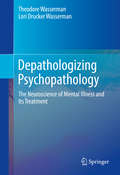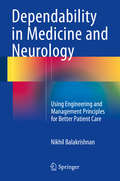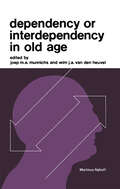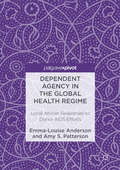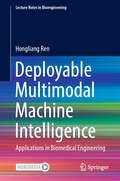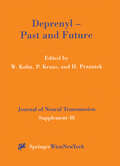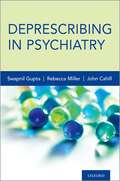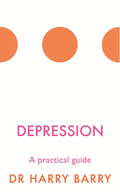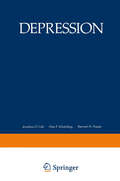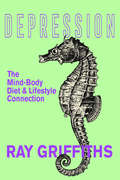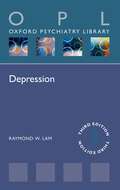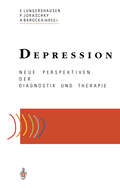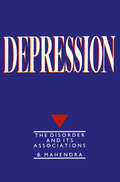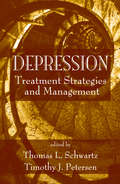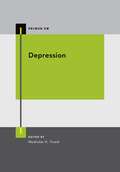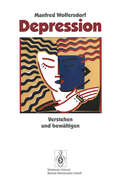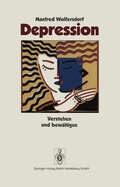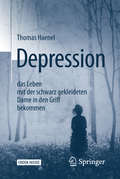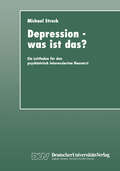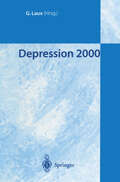- Table View
- List View
Depathologizing Psychopathology: The Neuroscience of Mental Illness and Its Treatment
by Theodore Wasserman Lori Drucker WassermanThis brief, accessible treatise harnesses the neurophysiological processes of learning to create an innovative and powerful approach to therapy. It sets out a non-pathologizing alternative not only to the current medicalized conception of diagnosis and treatment but also to the labeling of relatively normal reactions to stressors and upsets as illnesses. Rooted in the neurobiology of human learning, the book’s approach to treatment, Neuro-Cognitive Learning Therapy, characterizes maladaptive behavior patterns as learned responses to upsetting conditions—processes which can be unlearned. In addition, the coverage includes a clinical teaching guide for bringing NCLT theory and methods into the training curriculum.This groundbreaking volume:Proposes a non-stigmatizing learning model for therapy, Neuro-Cognitive Learning Therapy.Introduces the concept of the connectome and explains its critical role in mental health and illness.Differentiates between the unconscious and automaticity in cognition and behavior.Addresses the applicability of NCLT to biologically-based mental disorders.Offers case studies illustrating NCLT in contrast with commonly-used approaches.Includes a chapter-by-chapter clinical teaching guide with therapeutic principles and discussion questions.Provides a comprehensive therapeutic framework for practitioners of all orientations.Depathologizing Psychopathology gives neuropsychologists, psychiatrists, clinical social workers, and child and school psychologists new ways of thinking about mental illness and learning about learning for a bold new step in the evolution of mind/brain knowledge.
Dependability in Medicine and Neurology: Using Engineering and Management Principles for Better Patient Care
by Nikhil BalakrishnanThis ground-breaking title presents an interdisciplinary introduction to the subject of Dependability and how it applies in medicine generally and in neurology in particular. Dependability is the term applied in engineering and industry to a service that is safe, reliable and trustworthy. Dependable systems use a variety of methods to deliver correct service in the face of uncertainty resulting from misleading, erroneous information, and system faults. Dependable systems result from the application of systematic methods in design, operation, and management to deliver their services.Dependability in Medicine and Neurology presents the philosophy and ideas behind the specific methods of dependability and discusses the principles in the context of medical care and neurologic treatment especially. Patient case vignettes are used widely to illustrate key points. A first-of-its-kind title and based on the author’s many years of teaching these principles to medical colleagues throughout the United States, Dependability in Medicine and Neurology will inspire readers to develop applications for their specific areas of clinical practice. Intended for physicians (especially neurologists), medical students, nurses, and health administrators, Dependability in Medicine and Neurology is an indispensable reference and important contribution to the literature.
Dependency or Interdependency in Old Age
by Joep M. A. Munnichs and Wim J. A. HeuvelAlthough this monograph "Dependency o r interdependency in old age" is not the first publication o f the European Social Sciences Research C- mittee (ESSRC) o f the International Association o f Gerontology, I a m happy, as former chairman o f the Committee (1964-1975), to introduce this book to the readers, together with the present chairman. So far the activities o f the Committee have consisted o f co-operating in organizing the scientific programme o f the tri-annual congresses o f the International Association o f Gerontology (lAG), and in organizing sm- ler o r bigger symposia and colloquia for social gerontologists. Sometimes these meetings were mainly organized for European researchers only, sometimes several concurrent colloquia took place in which Americans and o t h e r non-Europeans participated. T h e Committee, the oldest o f the lAG, was established at a scientific meeting in 1954 at Sheffield (U. K. ) A f t e r that year colloquia were held in 1956 near Copenhagen 1 (Denmark), in 1957 at M e r a n o2 (Italy), in 1959 at Assisi (Italy), in 1960 a t Berkeley (Cal.
Dependent Agency in the Global Health Regime: Local African Responses to Donor AIDS Efforts
by Emma-Louise Anderson Amy S. PattersonThis volume examines how local actors respond to Africa’s high dependence on donor health funds. It focuses on the large infusion of donor money to address HIV and AIDS into Malawi and Zambia and the subsequent slow-down in that funding after 2009. How do local people respond to this dynamic aid architecture and the myriad of opportunities and constraints that accompany it? This book conceptualizes dependent agency, and the condition in which local actors can simultaneously act and be dependent, and investigates conditions under which dependent agency occurs. Drawing upon empirical data from Malawi and Zambia collected between 2005 and 2014, the work interrogates the nuanced strategies of dependent agency: performances of compliance, extraversion, and resistance below the line. The findings elucidate the dynamic interactions between actors which often occur “off stage” but which undergird macro-level development processes.
Dépistage et cancers cutanés (Dépistage et cancer)
by Bernard GuillotLes cancers cutanés, toutes formes confondues, sont les plus fréquents des cancers chez l'homme. Ils sont aussi les plus faciles à repérer puisque situés sur des zones accessibles au regard de beaucoup: malade, famille, soignants, médecins. Malgré cela, leur incidence est en croissance importante et régulière au fil du temps. Cette augmentation est en grande partie liée au vieillissement de la population générale mais aussi aux habitudes d'exposition solaire inadaptée d'une grande partie de la population. Ce paradoxe apparent entre une approche clinique qui semble simple et une incidence en augmentation constante conduit à penser qu'une meilleure identification des patients à risque pourrait permettre de repérer des populations particulières qui justifieraient des messages de prévention primaire spécifiques et une surveillance adaptée afin de faire un diagnostic précoce et donc de proposer un traitement réellement curatif. Cette stratégie est particulièrement vraie pour le mélanome, le plus agressif des cancers cutanés dont la mortalité reste encore trop élevée. En effet, au cours du mélanome, il est démontré qu'un diagnostic précoce est presque toujours synonyme de guérison. Cet ouvrage fait le point sur les aspects épidémiologiques de ces tumeurs en France et sur leurs aspects cliniques. Il propose une identification des marqueurs de risque et les lésions prédisposantes propre à chaque type tumoral. Une stratégie de diagnostic précoce des carcinomes d'une part et du mélanome d'autre part est proposée, en s'appuyant, notamment pour le mélanome, sur les nouvelles modalités du parcours de soin proposées aujourd'hui au malade.
Deployable Multimodal Machine Intelligence: Applications in Biomedical Engineering (Lecture Notes in Bioengineering)
by Hongliang RenThis book highlights the principles, design and characterization of mechanically compliant soft and foldable robots. Traditional rigid robots with bulky footprints and complicated components prolong the design iteration and optimization for keyhole and minimally invasive transluminal applications. Therefore, there is an interest in developing soft and foldable robots with remote actuation, multimodal sensing and machine intelligence. This book discusses the use of foldable and cuttable structures to design biomimetic deployable soft robots, that can exhibit a fair number of motions with consistency and repeatability. It presents the overall design principles, methodology, instrumentation, metamorphic sensing, multi-modal perception, and machine intelligence for creating untethered foldable active structures. These robotic structures can generate a variety of motions such as wave induction, compression, inchworm, peristalsis, flipping, tumbling, walking, swimming, flexion/extension etc. Remote actuation can control motions along regular and irregular surfaces from proximal sides. For self-deployable medical robots, motion diversity and shape reconfiguration are crucial factors. Deployable robots, with the use of malleable and resilient smart actuators, hold this crucial advantage over their conventional rigid robot counterparts. Such flexible structures capable of being compressed and expanded with intelligence perceptions hold enormous potential in biomedical applications.
Depraved Heart (A\scarpetta Novel Ser. #No. 23)
by Patricia CornwellNo. 1 New York Times bestselling author Patricia Cornwell delivers the twenty-third engrossing thriller in her high-stakes series starring medical examiner Dr. Kay Scarpetta.
Deprenyl — Past and Future (Journal of Neural Transmission. Supplementa #48)
by W. Kuhn, P. Kraus and H. PrzuntekExpert clinicians and basic scientists with a special interest in Parkinson's disease review the current state of science and clinical therapeutics of the disease. Therefore these articles represent an authorative review of the current state of knowledge regarding preclinical course and symptomatology, subtypes with their impact on the pathology, genetic alterations, novel mechanisms of neuronal cell death, diagnostic tools and old and novel therapeutic approaches with respect to neuroprotection and neuroregeneration in Parkinson's disease. Particular emphasis has been placed on a novel antiparkinsonian drug called budipine with various modes of action also influencing altered non dopaminergic systems in Parkinson's disease. It is evident, that many questions on the cause, course and treatment of Parkinson's disease are still unanswered and therefore the ideal way to treat a parkinsonian patient remains to be defined.
Deprescribing in Psychiatry
by Rebecca Miller John Cahill Swapnil GuptaThe current state of medicine has witnessed the long-term adverse effects of certain medications, an increased rate of polypharmacy, and a cultural shift that emphasizes patient-centered practice. The term ?deprescribing? refers to the optimization of the pharmacological regimen by reducing or cessing medications that incur more risks than benefits. Many people consider stopping their psychiatric medications, but prescribers may not know how to do this in a collaborative, systematic way. Deprescribing in Psychiatry presents a framework for deprescribing to guide the prescriber-patient dyad through the process of deciding if and when to reduce psychiatric medication, how to go about doing it, and at the same time, acknowledge the inherent risks in such an endeavour. As the first book on the subject, Deprescribing in Psychiatry stands to serve as a definitive text in this burgeoning field and as a 'rallying call' to raise crucial and topical questions in psychiatric practice, promote innovation, and act as a resource on the current state-of-the-art care. It describes the ins and outs of how clinicians can work closely with their patients to consider whether or not to try decreasing medications. It also discusses the anticipated future research directions, considerations for the field, and emphasizes collaboration with the patient, transparency, and the acknowledgement of uncertainty in psychiatric practice.
Deprescribing in Psychiatry
by Rebecca Miller John Cahill Swapnil GuptaThe current state of medicine has witnessed the long-term adverse effects of certain medications, an increased rate of polypharmacy, and a cultural shift that emphasizes patient-centered practice. The term ?deprescribing? refers to the optimization of the pharmacological regimen by reducing or cessing medications that incur more risks than benefits. Many people consider stopping their psychiatric medications, but prescribers may not know how to do this in a collaborative, systematic way. Deprescribing in Psychiatry presents a framework for deprescribing to guide the prescriber-patient dyad through the process of deciding if and when to reduce psychiatric medication, how to go about doing it, and at the same time, acknowledge the inherent risks in such an endeavour. As the first book on the subject, Deprescribing in Psychiatry stands to serve as a definitive text in this burgeoning field and as a 'rallying call' to raise crucial and topical questions in psychiatric practice, promote innovation, and act as a resource on the current state-of-the-art care. It describes the ins and outs of how clinicians can work closely with their patients to consider whether or not to try decreasing medications. It also discusses the anticipated future research directions, considerations for the field, and emphasizes collaboration with the patient, transparency, and the acknowledgement of uncertainty in psychiatric practice.
Depression: A practical guide (The Flag Series #3)
by Dr Harry BarryA practical, four step programme to help you understand and cope with depression. As many as 1 in 4 British people have depression at any one time, and despite being so prevalent in our lives and communities, there is still lingering reluctance to talk about depression and its effects. In Depression: A practical guide, Dr Barry is determined to break the silence and provide practical advice to those suffering from depression as well as their families and friends. Dr Barry reveals a simple, four step programme to deal with depression, from beginning the journey, how to feel better, how to get better and how to stay well. He explores holistic approaches involving lifestyle as well as drug therapy, talk therapy (particularly CBT) and mindfulness.Previously published as Flagging Depression, this edition has been fully revised and updated.
Depression: Biology, Psychodynamics, and Treatment (A\series Of Slide Lecture Programs #Vol. 4)
by Shervert H. Frazier Alan F. Schatzberg Jonathan O. ColeI have of late-but wherefore I know not-lost all my mirth, foregone all custom of exercises, and indeed it goes so heavily with my disposition that this goodly frame, the earth, seems to me a sterile promontory .... Hamlet, in Hamlet, Act II, Sc. 2. The numbers may have been fewer in Shakespeare's time, but the symp toms were the same. Now, each year, millions instead of thousands of people suffer from a clinical depression severe enough for them to seek help from medical and mental health practitioners. Depression is the most common of all psychiatric disorders and affects people of all ages-from childhood to senescence. Since it represents a major medi cal, public health, and social problem for our culture, it is vitally impor tant that physicians and mental health professionals of all disciplines have a current and thorough understanding of various aspects of the illness-its etiologies, biology, dynamics, course, treatment, and, in some cases, its long-term management. Depression has long been known to Western civilization with early references to it dating back to Homeric writings. In subsequent times, works of art have often portrayed individuals suffering from depression, and medical tomes have proposed a host of therapies, most of which are antiquated. Over time, however, our knowledge has steadily grown.
Depression: The Mind-Body, Diet and Lifestyle Connection
by Ray GriffithsThe part of the brain most heavily associated with mental health, memory, emotion and mood is called the hippocampus; the biological name for the seahorse. It is the unusual seahorse-like shape of the hippocampus that has led to its evocative name. Just as the seahorse charms the depths of oceans, our own hippocampus, when supported and nurtured, can help to enchant our own lives. Worryingly, there are an increasing number of scientific papers linking problems with the hippocampus to depression, in particular, the shrinking or failure to regrow this part of the brain after prolonged stress. Depression, anxiety and mood disorders are often seen as entirely psychological in cause. However, more and more research is highlighting that chronic health issues, poor diet and lifestyle choices can, and will, negatively impact our vulnerable hippocampus, and consequently, our mental health.Personalised nutritionist Ray Griffiths examines how we can modify our dietary and lifestyle choices to nourish our brain and hippocampus. These choices can help to cushion us from the harm we may encounter as we navigate the challenges of modern everyday life. This nourishment is absolutely vital, as every day our hippocampus can potentially regrow 700 brand new neurons, but it needs a huge amount of assistance to do so. Nourishment for the hippocampus can come from not just diet but also from balanced gut bacteria, social connection, exercise, an outdoors environment, music and dance. Learning how to support your brain health begins with what you eat.
Depression (Oxford Psychiatry Library)
by Raymond W. LamDepression is ubiquitous, but the number and range of physical and cognitive symptoms associated with major depressive disorder (MDD) means that many people do not present with emotional symptoms. The high prevalence of MDD with other medical illnesses means that other health professionals and physicians must also recognize and manage clinical depression in their patients. Part of the Oxford Psychiatry Library series, Depression, 3rd edition offers readers a succinct guide to the diagnostic and treatment issues that clinicians will encounter when working with patients with MDD. Offering critical discussions on the latest research, from DSM-5 and ICD-11, to the Canadian Network for Mood and Anxiety Treatments (CANMAT) guidelines, Depression ensures readers are kept abreast of the latest research in concisely written chapters. Each chapter begins with helpful key points and features up-to-date references for further reading. In addition, useful scales for assessing cognition and quality of life are included in the appendix, including recommendations for the use of new scales such as the Perceived Deficits Questionnaire (PDQ-5). Depression, 3rd edition is an invaluable resource and quick reference for busy clinicians wanting to expand their knowledge of current research. The book will appeal to clinical psychiatrists, trainees, specialist nurses, general practitioners, and other mental health professionals.
Depression: Applying Clinical Guidelines (Oxford Psychiatry Library Series)
by Raymond W. LamDepression is ubiquitous, but the number and range of physical and cognitive symptoms associated with major depressive disorder (MDD) means that many people do not present with emotional symptoms. The high prevalence of MDD with other medical illnesses means that other health professionals and physicians must also recognize and manage clinical depression in their patients. Part of the Oxford Psychiatry Library series, Depression, 3rd edition offers readers a succinct guide to the diagnostic and treatment issues that clinicians will encounter when working with patients with MDD. Offering critical discussions on the latest research, from DSM-5 and ICD-11, to the Canadian Network for Mood and Anxiety Treatments (CANMAT) guidelines, Depression ensures readers are kept abreast of the latest research in concisely written chapters. Each chapter begins with helpful key points and features up-to-date references for further reading. In addition, useful scales for assessing cognition and quality of life are included in the appendix, including recommendations for the use of new scales such as the Perceived Deficits Questionnaire (PDQ-5). Depression, 3rd edition is an invaluable resource and quick reference for busy clinicians wanting to expand their knowledge of current research. The book will appeal to clinical psychiatrists, trainees, specialist nurses, general practitioners, and other mental health professionals.
Depression: Neue Perspektiven der Diagnostik und Therapie
by Eberhard Lungershausen Peter Joraschky Arnd BarockaErscheinungsweisen, Entstehungs- und Behandlungsmöglichkeiten der Depression sind Thema des vorliegenden Buchs: Welche Rolle spielen z.B. neurobiologische Faktoren bei der Entstehung und Aufrechterhaltung der Depression? Welche Formen und Erscheinungsbilder nimmt die Depression im Kindes- und Jugendalter, in der Lebensmitte oder im Alter an? Welche therapeutischen Möglichkeiten haben Patienten? Auf diese und weitere Fragen gehen die Autoren in ihren Beiträgen ein und vermitteln dem Leser damit einen kurzgefaßten Überblick über "Neue Perspektiven der Diagnostik und Therapie" bei Depression.
Depression: The disorder and its associations
by B. MahendraThe purpose of this book is to acknowledge the universality of depression, to throw some light on those aspects of depression which are neglected in the more conventional treatments of the subject and also to attempt to provide a synthesis between the biological and socio-environmental factors which lead to the onset of depression and modify its course. A book devoted to depression has the advantage that it has the space at its disposal to explain and clarify concepts and promising ideas that a chapter in even a comprehensive textbook does not have. A single author writing about all the relevant aspects of a subject brings with him the merit of uniformity, continuity and lack of repetition. He is also more fallible in some areas than others, which finds an exact parallel in the experience of clinicians in their practice. A multi-author, multi-specialist work portrays an air of omniscience and omnicompetence which many clinicians find dispiriting. It is likely a considerable number of practising clinicians will have a greater knowledge and experience in some areas of the subject of this book. than I have and will feel emboldened to approach others. The entire work is informed by historical considerations. The lesson of history is to be open-minded and not to judge too harshly those that have gone before.
Depression: Treatment Strategies and Management
by Thomas L. Schwartz Timothy J. PetersenGuiding clinicians toward the most effective treatment regimens, this reference offers detailed coverage of the symptomatology, diagnosis, epidemiology, and etiology of depression. A must-have tool for anyone prescribing psychotropics or performing psychotherapy, this source expertly reviews research and clinical data regarding acute and long-term
Depression (Primer On Series)
by Steven M. StrakowskiMajor depressive disorder (MDD) is a serious, debilitating, life-shortening illness that affects many persons of all ages and backgrounds. The lifetime risk for MDD is 7-12% for men and 20-25% for women (Kessler et al., 2003). MDD is a disabling disorder that costs the U.S. over $200 billion per year in direct and indirect costs (Greenberg et al., 2015), and is the leading cause of disability worldwide (WHO, 2018). Depression also has detrimental effects on all aspects of social functioning (e.g., self-care, social role, and family life, including household, marital, kinship, and parental roles). While there have been several treatments that are efficacious, many individuals suffering from depression experience life-long challenges due to the chronic and episodic nature of the disease. Identifying strategies to find the right treatments for the right patients is critical. Ongoing research has explored the importance of examining physiologic biomarkers, as well as clinical characteristics to gain a better understanding of subtypes of depression, which will lead to improved treatments and better outcomes. This book provides an introduction to the etiology and pathophysiology of depression, common comorbidities and differential diagnoses, pharmacotherapy strategies, psychotherapeutic and neuromodulation interventions, novel and non-traditional treatment strategies, and considerations in special populations.
Depression (Primer On Series)
by Steven M. StrakowskiMajor depressive disorder (MDD) is a serious, debilitating, life-shortening illness that affects many persons of all ages and backgrounds. The lifetime risk for MDD is 7-12% for men and 20-25% for women (Kessler et al., 2003). MDD is a disabling disorder that costs the U.S. over $200 billion per year in direct and indirect costs (Greenberg et al., 2015), and is the leading cause of disability worldwide (WHO, 2018). Depression also has detrimental effects on all aspects of social functioning (e.g., self-care, social role, and family life, including household, marital, kinship, and parental roles). While there have been several treatments that are efficacious, many individuals suffering from depression experience life-long challenges due to the chronic and episodic nature of the disease. Identifying strategies to find the right treatments for the right patients is critical. Ongoing research has explored the importance of examining physiologic biomarkers, as well as clinical characteristics to gain a better understanding of subtypes of depression, which will lead to improved treatments and better outcomes. This book provides an introduction to the etiology and pathophysiology of depression, common comorbidities and differential diagnoses, pharmacotherapy strategies, psychotherapeutic and neuromodulation interventions, novel and non-traditional treatment strategies, and considerations in special populations.
Depression: Verstehen und bewältigen
by Manfred WolfersdorfWie können depressive Menschen Unterstützung in ihrem Umfeld erhalten, wie können sie sich selber helfen? Wichtige Informationen über Erscheinungsformen, Ursachen und Behandlungsmöglichkeiten werden fundiert vermittelt.
Depression: Verstehen und bewältigen
by Manfred WolfersdorfWas ist eigentlich eine Depression? Behutsam und verständlich baut Manfred Wolfersdorf Unwissenheit und Hemmungen gegenüber einer Krankheit ab, die immer noch mit Vorurteilen behaftet ist. Er geht auf Erscheinungsformen, Ursachen und Therapiemöglichkeiten ein und gibt Hinweise, worauf Ärzte, Angehörige, Freunde und die Betroffenen selbst achten müssen. Concise text: Manfred Wolfersdorf beschreibt verständlich Erscheinungsformen, Ursachen und Behandlungsmöglichkeiten von Depressionen. Praktische Ratschläge für den Alltag helfen Patienten und Angehörigen beim Umgang mit der Krankheit.
Depression – das Leben mit der schwarz gekleideten Dame in den Griff bekommen
by Thomas HaenelDieses Buch befasst sich mit dem breiten Spektrum der Depression, welche die am häufigsten auftretende psychische Erkrankung darstellt. Anschaulich erklärt der Autor sowohl die üblichen wie auch die speziellen Aspekte der Depression. Diese Facetten der Depression werden in Abgrenzung zum Burn-out und zur posttraumatischen Belastungsstörung aufgezeigt. Eindrücklich kommt auch die größte Gefahr der Depression zur Sprache, die Suizidgefahr, und wie diese im Rahmen der Prävention verhindert werden kann.Ein besonderes Gewicht wird auf die verschiedenen Formen der Depressionsbehandlung gelegt, und es wird dargestellt, wie diese Krankheit grundsätzlich gut behandelbar ist.Das vorliegende Buch ist für ein allgemeines Publikum geschrieben, erfordert keine Fachkenntnisse, ist leicht lesbar und richtet sich sowohl an Interessierte wie auch an alle, die mit dieser Krankheit zu tun haben, d. h. Betroffene und Angehörige, Ärzte, Therapeuten, Sozialarbeiter, Pflegefachpersonen, Lehrer und Seelsorger.
Depression — was ist das?: Ein Leitfaden für den psychiatrisch interessierten Hausarzt
by Michael StruckDas Buch setzt sich zum Ziel, den interessierten Hausarzt und Facharztanwärter für den Umgang mit affektiv Kranken zu sensibilisieren und ihm gleichzeitig profunde Sachkenntnis zu vermitteln.
Depression 2000
by G. LauxZum Jahrhundert- bzw. Jahrtausendwechsel sollen in diesem Buch aktuelle Aspekte zum Thema Depression dargestellt werden. Depressionen sind heute so häufige und wichtige Erkrankungen, dass sie in der gesamten Medizin berücksichtigt werden müssen. Nur etwa die Hälfte der Fälle wird richtig diagnostiziert und nur ca. 20% der Patienten werden adäquat therapiert. Absichtlich wurden Themenkreise gewählt, die über übliche Standardreferate hinausgehen bzw. häufig unberücksichtigt bleiben. Neben den neurobiologischen Grundlagen und ihren therapeutischen Implikationen werden Depressionsthemen wie Depression bei organischen Grunderkrankungen oder im Rahmen der Volkskrankheit Alkoholismus dargestellt. Der neuen Depressionsdiagnose Dysthymie, der Depression im Kindes- und Jugendalter sowie der postpartalen Depression und der Altersdepression sind separate Kapitel gewidmet.
